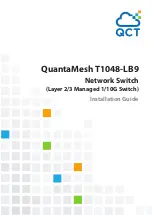
Chapter 2 Port Cabling and LED Indicators
The PICMG 3.1 standard defines an embedded Ethernet environment for Telco chassis. This
environment includes two switch fabric slots that create a dual star Ethernet network to the
fourteen node slots. Placing the Ethernet Switch Blade in a hub slot provides embedded Ethernet
services to each node card across the Packet Switching Backplane of the chassis. A standard
configuration is to place a Ethernet Switch Blade in each hub slot creating a redundant, high
availability system. This chapter provides information on the Ethernet Switch Blade port
connectors and LED indicators.
Connecting the Cables
Your switch setup may require some or all of the following types of cables: 10/100/1000 Port
Cabling
Category 5 cabling is required for all external ports. Be sure that your cable length is within the
minimum and maximum length restrictions for the Ethernet, otherwise you could experience
signal or data loss. All copper GigE ports on the Ethernet Switch Blade are auto-MDI sensing
and will automatically determine whether or not an MDI (straight-through) or MDI-X (crossover)
cable is attached.
Console Port Cabling
The switch console can be accessed via one RJ-45 10/100 service port located on the front panel
of the Ethernet Switch Blade.
NOTE: There are two switch portions that make up a Ethernet Switch Blade unit. Each
switch portion, Base and fabric, has its own console ports, and requires its own console
cable or OOB Ethernet cable.
The RS-232 configured RJ-45 connector console port on the front panel can be used to recover
from a system failure. It is used for maintenance only, and is generally not connected. Use a HP
console cable (P/N A6900-63006) provided with the HP bh5700 ATCA 14-Slot Blade Server, in
combination with a Modem Eliminator cable, to access the switch software through the console
port. Refer to the
HP bh5700 ATCA 14-Slot Blade Server Installation Guide
for additional
information.
Connecting to the Console Port
To attach the console cable to the OpenArchitect Base or fabric switch:
1. Plug the RJ-45 end of the console cable into the RJ-45 Console Port on the front.
2. Connect the Modem Eliminator cable to the DB-9 connector on the console cable.
3. Connect the other end of the Modem Eliminator cable to a standard COM port (9600, n,
8, 1).
Ethernet Switch Blade User's Guide
release 3.2.2j
page 23
Downloaded from
www.Manualslib.com
manuals search engine
















































